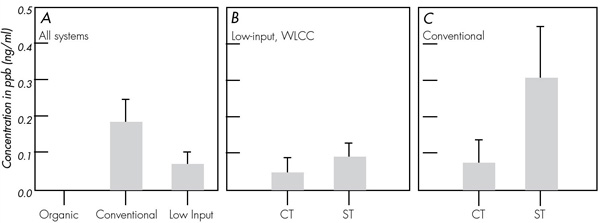| • Table of Contents • |
Summer 2007 - Vol. 7/No. 3
Effects of alternative agricultural practices on pesticide detection, concentration in runoff water
Introduction
The National Water Quality inventory has identified agricultural nonpoint source (NPS) pollution as the main impact to natural water sources (e.g. rivers and lakes),
as well as an important source of pollution to groundwater reserves. Agriculture pesticide use is a potential source of NPS pesticides to aquatic environments.
Agricultural impacts on surface water and ground water can be minimized by properly managing activities that cause NPS pollution through adopting practices that buffer or reduce the amount of runoff from agricultural fields. These include planting winter cover crops, reducing tillage or conservation tillage, and building sediment traps to collect winter rain and summer irrigation runoff. Cover crops protect soil from water erosion, and increase infiltration (SAFS Newsletter Winter/Spring 2006, Vol. 6, No.2). Sediment traps allow sediment to settle out of runoff water and thus reduce pesticide transport form fields.
To evaluate the effects of management practices on NPS in California row crop systems, samples of runoff water were analyzed for pesticides from nine plots at SAFS. Management treatments included conservation tillage (CT) and standard tillage (ST) across organic, low-input and conventional cropping systems in two-year tomato-corn rotation. Organic plots are managed according to the California Certified Organic Farmer guidelines and their nitrogen inputs from manure application and winter legume cover crops (WLCC). The low input system gets occasional application of pesticides with reduced conventional nitrogen inputs compared to the conventional cropping system and supplemental nitrogen from WLCC. The conventional system is strictly agrochemical based and reflects the Central Valley’s typical farming practices. Four pesticides were selected for monitoring based on pesticide application history from fall 2003 to summer 2005. These included: tillam (pebulate), trifluralin, metolachlor, and lambda (L)-cyhalothrin. Glyphosate was applied in all the fields used for this study, but was not analyzed due to lack of standard extraction and analysis method for this compound.
Sampling and analysis
One-liter event-based samples of winter runoff water were collected between January and April 2006 with an ISCO autosampler (Teledyne ISCO, Inc., NE) and processed within 24 hours.
Centrifuged samples were spiked with a surrogate standard (terbutylazyne) to evaluate recovery. The pesticides were extracted from the runoff water, deuterated
naphthalene and pyrene internal standards added and then analyzed using an HP 5973 Gas Chromatograph/Mass Spectrometer.

FIGURE 1. Average total pesticide concentration detected in samples from SAFS plots. Effects of standard tillage (ST) and conservation tillage (CT) on pesticide concentrations was determined in the low-input winter legume cover crop WLCC) system, and conventional system plots.
Results
A total of 41 runoff water samples from SAFS plots were collected during the 2006 winter storm season. During 2003 to 2005, conventional plots received tillam,
trifluralin, metolachlor and L-cyhalothrin; low input (WLCC) plots received Lcyhalothrin and no conventional pesticides were applied to organic plots. Trifluralin
and L-cyhalothrin were not detected in any runoff samples. Tillam was detected in two samples and metolachlor in 11 samples.
No pesticides above their detection limits were found in runoff from the organic cropping system. In low-input and conventional systems, runoff water from ST plots had consistently higher pesticide concentrations (Figure 1). The highest concentrations were detected in the ST conventional cropping system plots. This result was expected, given that conventional ST plots had more pesticides applied than any other plots (trifluralin, metolachlor and L-cyhalothrin). Specifically, metolachlor was detected in 62.5% of ST samples, while it was only detected in 25% of CT samples.
In low-input plots, the differences between CT and ST were greatly diminished. This was perhaps due to the fact that all low-input plots are planted with winter cover crops that can reduce the amount of runoff and export of sediment. Metolachlor was the pesticide predominantly detectedin the samples. Metolachlor is moderately persistent in the environment lasting up to one or two years. Metolachlor is the most water soluble of the four pesticides targeted in this study, which may explain why it was detected more frequently than the others.
Our results show that in conventional systems, some reduction of pesticide runoff was achieved by adopting CT. In organic and low input systems, pesticide usage was lower than in conventional systems and leading to pesticide runoff. Overall, the amount of pesticides measured in the conventional cropping system runoff was below detection limits with the exception of Metolachlor. The use of CT greatly reduced Metolachlor in runoff. The results indicate that management to reduce runoff is useful to reduce pesticide export.
We are currently analyzing data from four growers’ fields to evaluate and compare the effects of sediment traps, reduced tillage, cover crops and fallow fields on pesticide runoff during the rain season and during irrigation events.